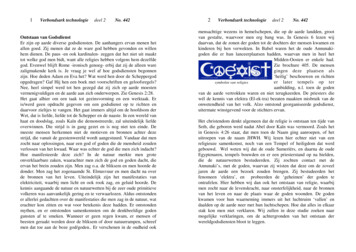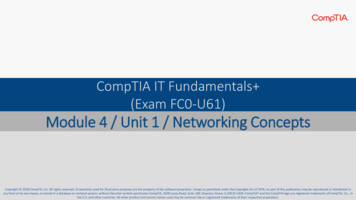
Transcription
An International d edition
Marketing FundamentalsAn International Perspective Noordhoff Uitgevers
To the memory ofEd CundiffMentor and long-time friend Noordhoff Uitgevers
MarketingFundamentalsAn International PerspectiveDr. Bronis VerhageProfessor of MarketingGeorgia State UniversityAtlanta, Georgia, USASecond edition, 2013Noordhoff Uitgevers Noordhoff Uitgevers
Design: G2K, Groningen / AmsterdamOmslagbeeld: Holland Heineken House / Copyright HeinekenComments on this or any other publication should be addressed toNoordhoff Uitgevers bvHigher Education DepartmentAntwoordnummer 139700 VB GroningenThe Netherlandse-mail: info@noordhoff.nl0 / 13This publication is printed on FSC paper. 2013 Noordhoff Uitgevers bv Groningen/Houten, The Netherlands.Subject to the exceptions provided for by or pursuant to the Copyright Act 1912, no partof this publication may be reproduced, stored in a computer data file or published, in anyform or in any manner whatsoever, by any electronic or mechanical means, includingphotocopying and recording, without the prior written permission of the publisher. To theextent that reproduction of this publication is provided for by article 16h of the CopyrightAct 1912, the appropriate fees, which are payable by law, are to be paid to StichtingReprorecht (P. O. Box 3060, 2130 KB Hoofddorp, The Netherlands, www.reprorecht.nl).Those wishing to include a short passage or passages from this publication in anthologies,readers and other compilations (as provided for by article 16 of the Copyright 1912) shouldcontact Stichting PRO (Stichting Publicatie- en Reproductierechten Organisatie, P.O. Box3060, 2130 KB Hoofddorp, The Netherlands, www.stichting-pro.nl). Those wishing to usea longer passage or passages should contact the publisher directly.All rights reserved. No part of this publication may be reproduced, stored in a retrieval system, ortransmitted, in any form or by any means, electronic, mechanical, photocopying, recording, orotherwise, without the prior written permission of the publisher.ISBN (ebook) 978 90 01 85690 8ISBN 978 90 01 81866 1NUR 802 Noordhoff Uitgevers
Brief ContentsPart 1 INSIGHT INTO MARKETING123What is marketing? 2Strategy development and marketing planning 40The marketing environment 102Part 2 ANALYSING THE MARKET456Buying behaviour 146Marketing research and marketing information 188Market segmentation and positioning 224Part 3 PRODUCT DECISIONS78Product strategy and services marketing 264New product development 324Part 4 PROMOTION DECISIONS91011Marketing communication strategies 368Advertising 414Sales management 458Part 5 PRICING DECISIONS12Pricing strategies and price determination 512Part 6 DISTRIBUTION DECISIONS131415 Noordhoff UitgeversDistribution 590Retailing 640Global marketing 690
ContentsPrefaceAbout the authorPart 1INSIGHT INTO MARKETING11.11.21.31.41.5WHAT IS MARKETING? 2Marketing in Action: L’Oréal’s global marketing strategy 4The meaning of marketing 71.1.1Differences between selling and marketing 71.1.2A definition of marketing 71.1.3The marketing mix 91.1.4Target market selection and the process of exchange 10Levels of marketing systems 111.2.1Macromarketing 111.2.2Mesomarketing 111.2.3Micromarketing 13Marketing Mistake: The French wine industry’s ‘Terroir’ 13Development of the marketing mindset 141.3.1Production- and product-oriented companies 151.3.2Selling-oriented companies 161.3.3Marketing-oriented companies 161.3.4Relationship marketing 18Practitioner’s Perspective: Jim Stengel (Procter & Gamble) 19The marketing concept 201.4.1Customer satisfaction 201.4.2Integrated approach 221.4.3Broad business definition 231.4.4Competitive analysis 231.4.5Marketing research and target market selection 231.4.6Profit contribution 25Marketing Topper: Levi’s versus the Consumers’ Association 25Tasks of marketing in a company 261.5.1Marketing’s first task 261.5.2Marketing’s second task 281.5.3The three Rs 291.5.4Customer equity 30Professor’s Perspective: Laetitia Radder (Nelson Mandela Metropolitan University) 31 Noordhoff Uitgevers
1.6Marketing applications and preview of the text 321.6.1Applications 321.6.2Non-profit marketing 331.6.3The need to study marketing 341.6.4A preview of the text 35Summary 36Discussion questions 382STRATEGY DEVELOPMENT AND MARKETINGPLANNING 402.12.22.32.42.52.62.72.8Marketing in Action: McDonald’s global ‘Plan to Win’ 42Marketing planning 442.1.1Differences between strategic and tactical planning 452.1.2Three levels of strategy development 462.1.3Building blocks of success 502.1.4A marketing planning and management model 50Marketing Mistake: Working without strategic plan 52Business definition and mission statement 532.2.1Formulating the business definition 542.2.2Defining the company’s mission 56Professor’s Perspective: Michael Porter (Harvard Business School, Boston, Massachusetts) 57SWOT analysis 582.3.1Internal analysis 582.3.2External analysis 592.3.3Situation analysis 602.3.4Confrontation matrix 61Marketing Topper: Spar’s retail strategy to beat Aldi 62Determining marketing objectives 632.4.1How to formulate objectives 642.4.2Hierarchy of objectives 66Developing a marketing strategy 672.5.1Portfolio analysis 682.5.2Boston Matrix 692.5.3Strategic implications 702.5.4Generic strategies 722.5.5Ansoff model 75Practitioner’s Perspective: Nilofer Merchant (Rubicon) 76The marketing organisation 782.6.1Organisational framework 782.6.2The marketing department 79Writing the marketing plan 812.7.1Why write a marketing plan? 812.7.2Marketing plan components 822.7.3Focus of marketing plans 90Implementation and control 912.8.1Evaluation and control 912.8.2Operational marketing control 932.8.3Strategic marketing control 952.8.4Integrated marketing 96Summary 98Discussion questions 101 Noordhoff Uitgevers
33.13.23.33.4THE MARKETING ENVIRONMENT 102Marketing in Action: How Nestlé fights high commodity prices 104Marketing environment 1073.1.1Internal environment 1073.1.2External environment 109Marketing Mistake: Nokia’s downfall 110Mesoenvironment 1113.2.1The supply chain 1113.2.2Customers 1133.2.3Suppliers 1143.2.4Intermediaries 1153.2.5Competitors 1163.2.6Public groups 118Marketing Topper: Going green makes good business sense 119The macroenvironment 1203.3.1Demographic factors 1223.3.2Economic factors 1243.3.3Political-legal factors 1243.3.4Ecological factors 1263.3.5Technological factors 1283.3.6Sociocultural factors 129Practitioner’s Perspective: Paul Polman (Unilever) 131Marketing ethics and social responsibility 1323.4.1Legislation versus ethics 1323.4.2Ethics and marketing 1333.4.3Insight into ethical behaviour 1343.4.4Social responsibility 137Professor’s Perspective: Dr. Ronald Jeurissen (Nyenrode Business University,Breukelen, The Netherlands) 137Summary 141Discussion questions 143Part 2ANALYSING THE MARKET44.14.2BUYING BEHAVIOUR 146Marketing in Action: How Heinz grows in emerging markets 148The purchase decision process 1514.1.1Problem recognition 1514.1.2Information gathering 1514.1.3Alternative evaluation 1524.1.4Purchase decision 1534.1.5Post-purchase evaluation 153Types of orientation and buying behaviour 1554.2.1Extensive problem solving 1554.2.2Limited problem solving 1564.2.3Routine problem solving 156Marketing Topper: A Diamond is Forever 157 Noordhoff Uitgevers
4.34.44.54.655.15.25.3Impact of personal circumstances 1574.3.1Demographic characteristics 1584.3.2Lifestyle 1584.3.3Situational influences 159Professor’s Perspective: Dr. Ken Bernhardt (Georgia State University) 160Psychological influences on consumer decisions 1604.4.1Needs and motives 1614.4.2Perception 1644.4.3Learning 1664.4.4Personality 1674.4.5Attitudes 168Practitioner’s Perspective: Diana Oreck (The Ritz-Carlton Hotel Co.) 170Social influences on consumer behaviour 1714.5.1Culture 1714.5.2Social class 1724.5.3Reference groups 1734.5.4Family influences 174Marketing Mistake: The B2B sales experience 177Business-to-business marketing (B2B) 1774.6.1Differences with consumer marketing 1784.6.2Organisational buying behaviour 1794.6.3Roles in the buying centre 1804.6.4Types of buying situations 182Summary 185Discussion questions 187MARKETING RESEARCH AND MARKETINGINFORMATION 188Marketing in Action: How the Internet changed the music business 190Role of marketing research 1935.1.1What is marketing research? 1935.1.2Objective of marketing research 194Practitioner’s Perspective: Finbarr O’Neill (J.D. Power and Associates) 195The marketing research process 1965.2.1Problem definition and research objectives 1975.2.2Developing the research plan 1985.2.3Secondary data research 2005.2.4Exploratory research 2005.2.5Refining the research design 2015.2.6Collecting primary data: survey methods 2025.2.7Motivation research 205Professor’s Perspective: Roland Rust (University of Maryland) 2075.2.8Observation 2085.2.9Experiments 2095.2.10 Analysing, interpreting and presenting research results 210Marketing Topper: Mining social media postings 211Marketing information system 2125.3.1Sources of information 2125.3.2Processing data 215Marketing Mistake: Omo Power: Unilever’s dirty laundry 216 Noordhoff Uitgevers
5.4Test marketing 2175.4.1Selecting test markets 2185.4.2Principles of test marketing 2195.4.3How long to test market? 219Summary 221Discussion questions 2226MARKET SEGMENTATION AND POSITIONING 2246.16.26.36.46.5Marketing in Action: How hotels target Gen Y 226Defining the market 2286.1.1What is a market? 2296.1.2Identifying the market 2306.1.3Analysing market potential 2316.1.4Demand and market approach 231Marketing Topper: Philips’ target market: 300 million poor people 233What is market segmentation? 2346.2.1Emergence of market segmentation 2346.2.2Reasons for market segmentation 2366.2.3Decision criteria for effective segmentation 237Practitioner’s Perspective: Eric Paquette (Copernicus Marketing Consulting) 239Bases for segmentation 2406.3.1Demographic segmentation 2406.3.2Geographic segmentation 2426.3.3Psychographic segmentation 2436.3.4Behavioural segmentation 245Professor’s Perspective: Dr. V. Kumar (Georgia State University) 246Targeting strategies 2476.4.1Target marketing decisions 2486.4.2Target market selection 250Marketing Mistake: Tata Nano: the world’s cheapest car 251Positioning strategies 2536.5.1The battle for the mind 2536.5.2Perceptual mapping 2546.5.3The art of positioning 2556.5.4Repositioning 256Summary 258Discussion questions 260Part 3PRODUCT DECISIONS77.1PRODUCT STRATEGY AND SERVICESMARKETING 264Marketing in Action: Manchester United’s global brand offensive 266What is a product? 2687.1.1A bundle of benefits 2697.1.2Product levels 2697.1.3Implications for marketing 270Practitioner’s Perspective: Salmin Amin (PepsiCo) 272 Noordhoff Uitgevers
7.27.37.47.57.67.77.888.18.2Types of consumer products 2737.2.1Convenience products 2747.2.2Shopping products 2747.2.3Specialty products 2757.2.4Unsought products 2767.2.5Other product classifications 277Product assortment strategies 2777.3.1What is an assortment? 2777.3.2Dimensions of the product mix 2787.3.3Optimising the product portfolio 2807.3.4Product line extensions 282Marketing Topper: How Mini outperforms Smart 284Managing the product life cycle 2857.4.1Stages in the life cycle 2867.4.2Usefulness of the product life cycle 2907.4.3Extending the life cycle 291Product quality and customer service 2927.5.1Product quality 2937.5.2Product warranty 2947.5.3Customer service 2957.5.4Relationship marketing 297Professor’s Perspective: David Aaker (University of California at Berkeley) 297Brand management 2997.6.1Strategic objectives of branding 3007.6.2Battle of the brands 3027.6.3Individual or family brand name? 3047.6.4What makes a brand name good? 3067.6.5Legally protecting the brand 307Marketing Mistake: Automobile brand names 308Product design and packaging 3087.7.1Design and styling 3097.7.2Packaging functions 309Marketing of services 3127.8.1Characteristics of a service 3137.8.2Importance of the service sector 3167.8.3Increasing productivity 317Summary 319Discussion questions 322NEW PRODUCT DEVELOPMENT 324Marketing in action: Reverse innovation from emerging markets 326What is a new product? 3288.1.1Types of new products 3298.1.2How innovation affects consumers 331Reasons for product development 332Professor’s Perspective: Albert Alos (Pan-African University, Laos, Nigeria) 3338.2.1Why firms introduce new products 3338.2.2Make or buy? 336 Noordhoff Uitgevers
8.38.48.58.6Developing new products 3388.3.1New product strategy development 3398.3.2Idea generation 3408.3.3Screening and evaluation 3408.3.4Business analysis 3418.3.5Prototype development 3438.3.6Test marketing 3438.3.7Commercialisation 344Practitioner’s Perspective: Michael O’Leary (Ryanair) 345Organising new product development 3468.4.1Venture teams 3478.4.2Alternatives to venture teams 3478.4.3Speeding up new product development 348Marketing Topper: Alfa Romeo: Italy’s next global luxury brand? 349Why new products succeed or fail 3518.5.1Successful introductions 3518.5.2Failed introductions 352Marketing Mistake: Size matters in global marketing 354Diffusion of innovations 3568.6.1The consumer adoption process 3568.6.2Adopter categories 3578.6.3Product features and rate of adoption 360Summary 363Discussion questions 365Part 4PROMOTION DECISIONS99.19.29.3MARKETING COMMUNICATION STRATEGIES 368Marketing in action: Why Hyundai is targeting Europe 370What is marketing communication? 3739.1.1Marketing communication and promotion tools 3739.1.2Comparing personal and mass communication 3759.1.3How does communication work? 377Professor’s Perspective: Don Schultz (Northwestern University) 379Communication strategy: target audience 3809.2.1Pull and push strategies 3819.2.2Two-step flow of communication 382Practitioner’s Perspective: John Bissell (Gundersen Partners) 384Setting communication objectives 3859.3.1Classic response hierarchy models 3879.3.2Implications for promotional strategies 3909.3.3Non-classic response hierarchy models 391Marketing Mistake: Benecol: failing functional food? 393 Noordhoff Uitgevers
9.49.59.6Establishing the communication budget 3949.4.1Percentage-of-sales method 3959.4.2Affordable method 3969.4.3Competitive-parity method 3969.4.4Objective-and-task method 3979.4.5Anti-cyclical budgeting 398Marketing Topper: Exporting the magic of London taxis 399Determining the communication mix 4009.5.1Guidelines for choosing an ideal mix 4019.5.2Intended consumer response 403Public relations 4049.6.1Public relations functions 4069.6.2Planning the PR strategy 407Summary 410Discussion questions 41210 ADVERTISING 41410.110.210.310.410.510.610.710.8Marketing in Action: Sesame Street in Africa 416The role of advertising 41910.1.1Influence on society 41910.1.2Place in the organisational structure 420Practitioner’s Perspective: Silvia Lagnado (Unilever) 421Types of advertising 42210.2.1Classified by sender 42210.2.2 Classified by target audience 42410.2.3 Classified by message 42510.2.4 Classified by medium 427Professor’s Perspective: Leslie de Chernatony (University of Birmingham, U.K.) 428Advertising planning 42810.3.1Establishing advertising objectives 42910.3.2 DAGMAR model 431Advertising strategies 43210.4.1Introduction stage 43310.4.2 Market growth stage 43410.4.3 Market maturity stage 43410.4.4 Market decline stage 435Developing the advertising campaign 43610.5.1Briefing 43710.5.2 Creative concept 43910.5.3 Execution 440Marketing Topper: Dos Equis: Heineken’s star in the U.S. 440Media selection 44110.6.1The media plan 44210.6.2 Criteria for selecting media 443Measuring advertising effectiveness 44710.7.1Pretesting 44710.7.2 Posttesting 448Marketing Mistake: Ambush marketing: hijacking the Olympics 449Sponsorships 45110.8.1Objectives 45210.8.2 Sponsorship strategies and assessment 452Summary 454Discussion questions 456 Noordhoff Uitgevers
11 SALES MANAGEMENT 458Marketing in Action: The CMO’s global challenge 46011.1 Importance of personal selling 46311.1.1Types of sales jobs 46311.1.2Multiple roles of salespeople 46511.2 The selling process 46711.2.1Preparation 46711.2.2Persuasion 46811.2.3Transaction 470Marketing Mistake: Sales versus marketing – still at war? 47211.3 Sales management and objectives 47311.3.1Managing the sales effort 47411.3.2Management by objectives 474Professor’s Perspective: Russell Abratt (Nova Southeastern University) 47711.4 Sales force structure 47711.4.1Organising the sales force 47811.4.2Sales force size 48111.4.3Sales territory allocation 482Marketing Topper: Google’s Internet bus in India 48411.5 Building and managing the sales force 48511.5.1Recruitment, selection and training 48511.5.2Sales force motivation and compensation 487Practitioner’s Perspective: Jack and Suzy Welch 48911.6 Direct marketing 49011.6.1What is direct marketing? 49111.6.2Direct marketing forms 49311.6.3Evolution of direct marketing 49611.7 Sales promotion 49611.7.1Objectives of sales promotion 49711.7.2Consumer promotions 49911.7.3Trade promotions 50211.7.4Current trends in sales promotion 505Summary 507Discussion questions 509Part 5PRICING DECISIONS12 PRICING STRATEGIES AND PRICE DETERMINATION 51212.1Marketing in Action: The value proposition in multichannel retailing 514The pricing decision 51712.1.1Perceived value 51812.1.2Cost of the product 51912.1.3Company and marketing strategy 52012.1.4Competition 52012.1.5Product mix 52112.1.6Resellers 52112.1.7Legislation and ethics 521 Noordhoff Uitgevers
12.2 Demand curve 52212.2.1Price mechanism 52212.2.2 Movement along the demand curve 52312.2.3 Shifts of the demand curve 523Professor’s Perspective: Dr. Ken Bernhardt (Georgia State University) 52512.3 New product pricing 52612.3.1Price skimming strategy 52612.3.2 Penetration price strategy 52812.4 Pricing objectives 53012.4.1A model for pricing decisions 53012.4.2 General pricing objectives 53112.4.3 Specific pricing objectives 53112.4.4 Pricing objectives in practice 533Practitioner’s Perspective: Rick Wartzman (The Drucker Institute) 53612.5 Pricing methods 53712.5.1Base price 53812.5.2 Discounts and allowances 53812.5.3 Transfer pricing 54112.6 Cost-oriented pricing 54312.6.1Cost-plus pricing 54412.6.2 Variable-cost pricing 54712.6.3 Break-even analysis 54912.6.4 Target-return pricing 551Marketing Mistake: Buick’s reintroduction in China 55212.7 Demand-oriented pricing 55412.7.1Price elasticity of demand 55412.7.2 Income elasticity of demand 55912.7.3 Cross elasticity of demand 56112.7.4 Price lining 56212.7.5 Price differentiation 56412.7.6 Psychological pricing 566Marketing Topper: Smirnoff’s pricing strategy 56912.8 Competition-oriented pricing 57012.8.1Competition and market structures 57212.8.2 Monopoly 57412.8.3 Oligopoly 57412.8.4 Monopolistic competition 57712.8.5 Pure competition 57812.8.6 Competitive bidding 579Summary 582Discussion questions 586 Noordhoff Uitgevers
Part 6DISTRIBUTION DECISIONS13 DISTRIBUTION 59013.113.213.313.413.5Marketing in Action: Zara’s global stretch: one size fits all? 592Importance of marketing channels 59413.1.1What is a distribution channel? 59513.1.2Types of distribution channels 59613.1.3Distribution channels create utility 59813.1.4Distribution channels increase efficiency 59913.1.5Distribution channels create a supply chain 60013.1.6Value chain 601Professor’s Perspective: Jagdish Sheth (Emory University) 602Target market coverage 60313.2.1Intensive distribution 60413.2.2 Selective distribution 60513.2.3 Exclusive distribution 60613.2.4 Optimal level of distribution intensity 607Marketing Mistake: Benetton’s colours start to fade 608Channel leadership and management 61013.3.1Who should lead the marketing channel? 61013.3.2 Selecting channel members 61413.3.3 Channel conflict 61713.3.4 Evaluation and control of distributors 619Marketing Topper: Keeping up with Africa’s middle class 621Wholesaling 62213.4.1What is a wholesaler? 62313.4.2 Types of wholesaling 62313.4.3 The future of wholesaling 626Practitioner’s Perspective: Julian Glover (6x6 Creative Ltd, UK) 628Marketing logistics 62913.5.1Key activities in logistics 63013.5.2 Strategic issues in physical distribution 634Summary 636Discussion questions 63914 RETAILING 640Marketing in Action: How IKEA offers value for money 64214.1 The role of retailing 64514.1.1Importance of retailing 64514.1.2The wheel of retailing 646Marketing Mistake: Wal-Mart flunks German 64814.2 Types of retail operations 64914.2.1Major types of retail stores 65014.2.2 Non-store retailing 65514.2.3 Shopping centres 657Practitioner’s Perspective: Andreas Schaaf (BMW India) 660 Noordhoff Uitgevers
14.3 Online marketing 66114.3.1Overview of e-commerce 66214.3.2 Benefits of Internet retailing 66314.3.3 Cornerstones of e-marketing 665Marketing Topper: Abercrombie’s retail theatre in Europe 66814.4 Franchising 66914.4.1Forms of ownership 67014.4.2 Types of franchise arrangements 67014.4.3 Advantages and disadvantages of franchising 67114.5 Key account management 67314.5.1Dual target market approach 67414.5.2 Low margin and service retailing strategies 675Professor’s Perspective: Nirmalya Kumar (London Business School) 67614.6 Retail marketing 67614.6.1Store image: positioning the retail store 67714.6.2 Retailing mix 67914.6.3 Recent trends in retailing 683Summary 686Discussion questions 68815 GLOBAL MARKETING 690Marketing in Action: Why McDonald’s is going ‘glocal’ 692International marketing planning 69515.1.1What is global marketing? 69615.1.2Strategic planning for international expansion 697Professor’s Perspective: S. Tamer Cavusgil (Georgia State University) 70015.2 Global marketing environment 70115.2.1Economic environment 70115.2.2 Political-legal climate 704Marketing Topper: Oreo: East meets West 70715.2.3 Cultural environment 708Practitioner’s Perspective: Elizabeth L. Ward (Thought Partners Consulting) 71215.3 Market entry strategies abroad 71315.3.1Exporting 71315.3.2 Joint ventures 71615.3.3 Direct investment 717Marketing Mistake: Cross cultural blunders 71815.4 Customisation or globalisation? 71815.4.1Pros and cons of standardisation 71915.4.2 Think globally, but act locally. 72015.4.3 Developing a global marketing strategy 721Summary 724Discussion questions 72615.1Chapter Notes 728Credits 740Index 743 Noordhoff Uitgevers
PrefaceIntroductionWe live in an exciting period of rapid changes and major challenges. In order tocompete successfully, firms must continue to launch better products and services.Marketing strategies considered excellent a few years ago, might not suffice intoday’s dynamic markets. A company must systematically differentiate its brandsand pursue an effective marketing strategy.Never before in the history of marketing have changes in the businessenvironment occurred so quickly and relentlessly. The corporate world has becomemore global and competitive. Companies have succeeded in cutting developmentand launch time for new products in half. Their products and services are not onlyof high quality, but also carefully tailored to the needs and wants of the targetmarket. As a result of numerous innovations, distribution costs have been slashed,while customer service continues to be improved. This tremendous progress inthe marketing of goods and services has been accomplished by replacing outdatedbusiness practices with new marketing insights and techniques. In executingtheir strategies, for example, many managers now rely on social media, guerrillamarketing and other communication methods that make effective use of theInternet. The Internet also gives small start-up companies access to the internationalmarket. By systematically applying contemporary marketing fundamentals andtechniques in this progressive new domain, any firm can improve its competitiveposition.Reasons for writing this bookAn important goal of those who work in higher education is to help students gainuseful insights and skills, preparing them for leadership positions in organisationsaround the world. This is a demanding task for educators. Traditional Americanconcepts that dominate most marketing books may not be adequate in today’sglobal market. Neither are the domestic examples and voluminous lists ofdefinitions that comprise many US textbooks.To be prepared for successful careers and the 21st century challenges they willface as managers in the global economy, students should not only be familiarwith the principles of marketing, but must also be able to develop and implementeffective marketing strategies abroad. Helping to equip students with a professionalattitude, as well as the knowledge and practical skills required to take advantageof international marketing opportunities, was the driving force behind theintroduction of Marketing Fundamentals: An International Perspective. Future managersmust be able to use their skills in organisations that market in countries and culturesother than their own.Global companies are increasingly interested in recruiting a new generation ofmanagers who apply the marketing fundamentals in creative ways and have acquiredhands-on skills. Ideally, they are ambitious yet realistic team players, who operate asflexible but results-driven managers, and can work independently in innovative andcustomer-focused ways.Today’s students are tomorrow’s marketers and leaders who have learned toanticipate change in a turbulent global environment and to think in an analytical,multi-disciplinary fashion. Marketing Fundamentals: An International Perspective willmake a significant contribution to cultivating this mindset. The book will prepare Noordhoff Uitgevers
students for the challenges ahead by engaging and motivating them to learnabout marketing management and by encouraging them – through internationalmarketing examples, cases and insightful perspectives – to practice making soundmarketing decisions.PositioningThis contemporary text was developed to introduce students to the fundamentals,practices and analytic techniques of marketing. It is comprehensive in scope andmanagerial in orientation. The book is designed to facilitate student learningfrom individual reading and independent study, which is increasingly importantin marketing education. The main objective is to help students deepen theirunderstanding of marketing and develop the skills to become successful, marketoriented managers, who are able to satisfy their customers – no matter where theylive – in this new era of cutthroat competition.How does this book differ from most other English-language marketing textbooks used in universities, colleges and business schools in Europe? Verhage’sMarketing Fundamentals features a unique European viewpoint, embedded in aglobal context. With its key marketing concepts tailored to fit the internationalframework of the text – such as management’s strategic perspective and focus onsocial responsibility, ethical and sustainability concerns – the book incorporatesa teaching style and marketing curriculum preferred in Europe’s internationallyoriented business schools.In each of the book’s 15 chapters, there are five mini-cases and professionalperspectives. Featured companies include Ryanair, Philips, L’Oreal, BMW, Google,Zara, Ikea and many others. The book also analyzes marketing strategies used in thehotel industry, music business, and by Manchester United.Pedagogical approachMarketing Fundamentals’ engaging, lively writing style enhances student learning.The use of ‘easy reading’ language especially appeals to non-native speakers ofEnglish. Its up-to-date, comprehensive coverage of marketing concepts and bestpractices helps to broaden the scope of marketing beyond the traditional marketingmanagement paradigm, which has long dominated the field.The revised 2nd edition of the book offers a contemporary review of newpriorities in marketing, as illustrated by a fascinating selection of analyses ofworld-class companies’ customer-focused strategies. These memorable and oftenprovocative examples of marketing practices include large and small companies,working in both business-to-business and consumer marketing of products orservices. Their strategies and performance make clear that marketing is a universalfunction, essential to any company that wants to achieve outstanding results in themarketplace.Structure of the textMarketing Fundamentals’ clear structure and managerial approach are identical to theDutch-language version, Grondslagen van de Marketing (8th edition). This book – themarket leader in the Netherlands for three decades – has been used by hundreds ofthousands of students and has created a great deal of enthusiasm about marketing.The topics in Marketing Fundamentals are arranged in a straightforward, logicalmanner. The book begins with a discussion of foundation concepts, strategydevelopment and changes in the marketing environment, including an overviewof ethical and social responsibility issues affecting marketing. It also highlightsmarketing planning, organising the marketing efforts and developing a marketing Noordhoff Uitgevers
plan. The next three chapters take an in-depth look at buyer behaviour and twoimportant marketing tools: marketing research and market segmentation. Itemphasises the need for effective relationship marketing, targeting and positioningstrategies.The remaining chapters of the book address the elements of the marketingmix: product, promotion, pricing and place (including online marketing), allfrom a decision-making perspective. The final chapter (Chapter 15) tackles thechallenges of plotting and implementing a global marketing strategy. Today,global competititon is so intense that every manager should attempt to identifyinternational marketing trends and opportunities promptly, in an effort to remaincompetitive. Therefore, cutting edge techniques as well as intriguing cases andillustrations of successful global marketing strategies are integrated throughout thetext.Key features of the bookThe second edition of Marketing Fundamentals features updated
Marketing in Action: L’Oréal’s global marketing strategy 4 1.1 The meaning of marketing 7 1.1.1 Differences between selling and marketing 7 1.1.2 A defi nition of marketing 7 1.1.3 The marketing mix 9 1.1.4 Target market selection and the process of exchange 10 1.2 Levels of marketing









